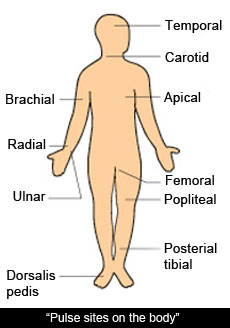Need to Know
Locating a Pulse

The pulse that you will learn to take is the radial pulse. To find a radial pulse:
- Have the person lie down or sit, relaxing their arm at their side, or comfortably across their lap.
- Place the tips of your first two fingers over what is called the radial groove. The groove is along the thumb side of the wrist between the hard tendon and long bone of the lower arm. There, you will feel a soft spot, where the radial artery is located.
- You will feel the pulse wave or throbbing sensation against your fingertips. Do not use your thumb to check the pulse, because you can feel your own pulse in your thumb.
- It helps to extend the person’s wrist just a bit with their palm side down to make it easier to feel the pulse.
- The normal pulse is about 70 to 80 beats per minute at rest; however, the heart rate, can range from 60 to 100 beats a minute.
When to Take a Pulse
Take a pulse in the following situations:
- When you are starting a new exercise or fitness program.
- When you are caring for someone who has a pacemaker
- When you are caring for someone who is having physical distress, such as dizziness, shortness of breath, or feeling “racing or funny heartbeats”. When a person feels like their heart is beating too fast and he or she can feel it beating differently than normal. This is called having heart palpitations.
- When you are caring for someone who has a history of blocked arteries, veins, or has blood clots.
- To find out how a person is reacting to medicines that can affect the heart
- To decide if there is a change in a person that requires calling a doctor
When you take a pulse – you should be able to easily feel the pulse wave push against your fingers in an even, regular pattern, without any missed beats. It feels like a tap against your fingertips.
Keep a record
Keep a record of the person’s morning pulse rates in a diary. If the person you are caring for follows an exercise program, record the pulse rate before (at rest), during, and after exercising. Record how well the person tolerates the exercise session. Did the person have any pain? Difficulty breathing? Feel more fatigued than usual? Keeping track of pulse rates will help you learn the person’s usual pulse rate for different activities. You will then be able to identify problems with the person’s pulse rate more quickly.
Devices for Maintaining a Heart Rate
Some people with heart disease have surgery to place special devices under the skin in the chest. These devices keep the heart rate and rhythm regular and within the normal range of beats per minute. These devices are called a pacemaker and an implantable cardioverter-defibrillator (ICD).
A pacemaker's wires pass through a large vein into a chamber of the heart. The pacemaker sends out mild electrical pulses that keep the heart from beating too slow. A doctor will prescribe the minimum rate that the pacemaker is set.
An implantable cardioverter-defibrillator (ICD) is placed under a person’s skin, usually below the left collarbone. A wire threaded through a large vein connects the device to the heart. An ICD is always checking the person’s heart rate. If the heart starts beating dangerously fast, the ICD sends a strong electrical shock to the heart to return it to a normal rhythm. If the heart is beating too slow, the ICD acts as a pacemaker, sending mild electrical pulses to make the heart beat at a faster rate. The doctor will give guidelines for having each of these devices checked on a regular basis.
What Affects a Person’s Heart Rate?
Factors that normally raise a heart rate:
- Exercise
- Stress
- Fever
- Extreme heat
- Standing or sitting down
- Anxiety
- Medicines such as “cold medicine”, decongestants, diet pills, amphetamines, asthma medicines
- Cigarettes
- Caffeine
- Alcohol
- Anemia – not enough blood cells to carry oxygen to all parts of your body
- Overactive thyroid gland
- Heart disease – With some conditions, the heart has to work harder, so it beats faster
Factors that normally lower a heart rate:
- Lying down
- Exposure to the cold
- Some heart and blood pressure medicines
- Heart disease – problems with the heart’s pumping ability
- Underactive thyroid gland.
- Regular exercise that increases the heart rate (such as running, or walking) conditions the heart muscle to pump a larger amount of blood to the body, requiring less beats per minute
Many older adults don’t think of themselves as athletes but have lower heart rates because they walk daily.
If any of these factors are in place when you take a heart rate, be aware of them as they can explain why a person’s heart rate is higher or lower than their normal rate.